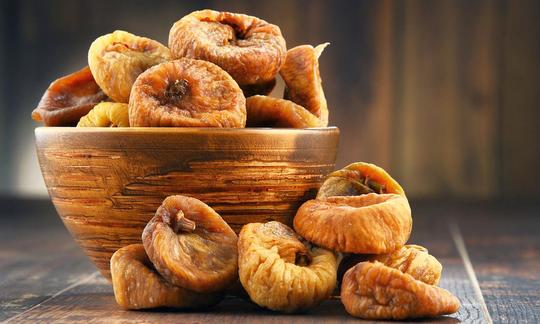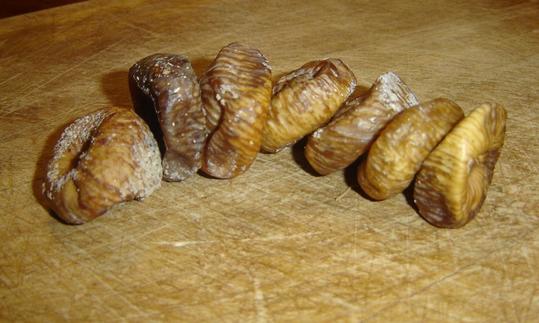Table of contents
Dried figs ( Ficus carica ) contain up to 60% sugar, which is why they should be consumed with caution. They are often dried (heated) in convection ovens or under hot steam, which is something raw foodists should take into account.
Use in the kitchen:
Dried figs are dried real figs and, due to their high sweetness, are also very good as a dessert. To refine pastries, cakes or other desserts, they can be chopped or pureed. The well-known fig bread is made from dried figs, almonds and spices. To make processing easier, dried figs can be soaked in water overnight before use.
Two or three chopped figs in your morning muesli give it a pleasant sweetness. Dried figs add a delicious southern touch to salads, soups or stews. Fig jam made from dried fruit is a good way to preserve them even longer. Dried figs are considered an energy bomb because they contain a lot of nutrients as well as a high carbohydrate content. Figs are usually eaten in moderation, but for athletes they are very suitable as an energy boost.
Vegan recipe for energy balls with figs:
Ingredients: 100 g dried figs (or dates ), 100 g cashews (or healthier: macadamia nuts ), 4 tbsp amaranth , 1 tbsp fresh lemon juice .
Preparation: Chop all ingredients in a blender or food processor until the mixture is sticky. There may still be some pieces left. Form the mixture into small balls with wet fingers and roll in sesame seeds , sunflower seeds , chia seeds or coconut flakes as desired. Before eating the energy balls, you should keep them in the fridge for a few hours.
| Not only vegans or vegetarians should read this: Vegans often eat unhealthily. Avoidable nutritional mistakes . |
Shopping - where to buy?
You can buy dried figs all year round in almost every supermarket such as Coop , Migros , Denner , Volg , Spar , Aldi , Lidl , Rewe , Edeka , Hofer etc. Look for unsweetened, organically produced and, if possible, unsulfured products. The fruits available in rolls are pressed using hot steam. To maintain raw food quality, you can dry them yourself at temperatures below 42 °C (= raw , see next point). Or you can go to an organic supermarket (such as Denn's Biomarkt , Alnatura ) or organic store of your choice to get products that are as close to natural as possible. They are sure to also offer sun-dried and gently dried fruits.
Sulfur-free, organically produced figs are washed only with salt water and shock freezing is suitable for commercial use to kill pests. UV light is used to prevent the formation of mold so that fungicides do not have to be used. A white film often forms on the dried fig. This is not mold, however, but rather leaked fructose. 1
It is often difficult to obtain dried figs without signs of a previous "inhabitant" (worm). The former inhabitants can be recognized by dark brown spots, which are also quite dry compared to the rest of the light and sticky flesh. Most people are not bothered by this, however. At least in southern countries, compact products with figs can be bought. In these cases, it is more worthwhile to look out for active infestation (by small beetles or worms).
Homemade preparation:
Fresh, fully ripe figs are also very easy to dry yourself. The best way is in a dehydrator or in the oven. After washing and dabbing dry, place the figs on a drying rack or the oven rack. Do not use a baking tray, as the fruit needs air to "breathe". Baking paper is also out of place here. To shorten the drying time, you can also cut the figs into smaller pieces. A space of one centimeter between the fruits is sufficient.
It is recommended to dry the figs at a temperature of around 50 °C. Note that the temperature for a raw food product should not exceed 42 °C. At 50 °C, the fruits are turned after around 5 hours. To achieve the desired consistency, they must remain in the dehydrator for at least another 5 hours.
After 10 hours, it is best to check every hour whether the figs have the desired consistency. The surface should be leathery and there should be no liquid visible on the surface. 2
In countries where this is possible, figs can also be dried in the sun. However, it is difficult to control the temperatures here, as this depends not only on the amount of sunlight but also on the subsoil.
Storage:
If the figs are sufficiently dried, they will last for about a year. To do this, you need to store them in a place that is as airtight and cool as possible. Ideally in a jar with a lid, in the cellar, pantry or even in the refrigerator.
Ingredients - nutritional value - calories:
Dried figs contain only 18-33% water, while the carbohydrate content (glucose, fructose and sucrose) increases to around 60%. Dried figs therefore have a relatively high energy content of 249 kcal/100g. 3
But the content of minerals and trace elements is also concentrated here. Dried figs also contain biotin (ex vitamin B 7 ) , at 18 µg/100g . This water-soluble vitamin is important for the breakdown of many amino acids and also plays a central role in the modification of histones in the cell nucleus. Pistachios and dried bananas have similar values. Dried porcini mushrooms have much higher values at 94 and brewer's yeast at 115 µg/100g. 3
Dried figs also have a high potassium content. With 680 mg, 100 g cover about a third of the daily requirement. This macronutrient is important for the membrane potential in the cells. Dates and hazelnuts have a similar amount of potassium per 100 g. Dried spices usually have a lot of potassium, such as coriander leaves with 4,466 mg/100g. 3
Manganese is also well represented in dried figs at 0.52 mg/100g. This trace element is very important for the formation of cartilage tissue and is found in high quantities in cloves (60 mg/100g) and ginger (33 mg/100g). Lentils and carob powder have a similar amount of manganese to dried figs. 3
Dried figs also contain vitamin K , calcium and magnesium .
You can find all the ingredients, the coverage of the daily requirement and comparison values with other ingredients in our nutrient tables. In the article Nutrients explained you will get a detailed insight into the topic.
Health aspects - effects:
How healthy are dried figs? The easily digestible dried fruits keep the digestive system healthy with their high fiber content when consumed regularly. Their laxative and diuretic effect helps with constipation. Similar to dried plums (damsons), dried figs should also be soaked beforehand to achieve this effect. 4
Another area of application is bronchial diseases: Figs are effective against infections in general, but especially when dried and soaked. They clear the chest, relieve coughing, make expectoration easier and soothe the airways. Chronic bronchitis, but also acute respiratory infections caused by flu and colds, are often treated with figs soaked in milk (including plant-based milk) and cooked. 4
The antioxidants contained in these dried fruits fight free radicals and make skin and hair look healthier. The potassium they contain helps to keep blood pressure stable.
The tonic effect of figs helps with fatigue caused by organic or psychological factors. Figs are also recommended for anemia. The nutritious dried fig is particularly recommended for pregnant women, nursing mothers, athletes and mentally challenged people (pupils and students). 4
Dangers - intolerances - side effects:
Some sensitive people react to sulphurized dried fruit with headaches or nausea. Certain asthmatics even react to sulphur compounds with asthma attacks. In rare cases, pseudo-allergies occur. This sulphur is harmless for healthy people. However, since it is only used to make the fruit look nicer (prevents it from darkening), it should be avoided. 5
The residual moisture contained in the fruit can cause mold to form, and the black mold that grows inside the fruit is particularly difficult to combat biologically. In this case, the fig must be opened and visually inspected before consumption. Aflatoxins or mycotoxins (metabolic products of mold) are often found in dried fruit. Chronic consumption of these toxins can be carcinogenic and mutagenic and can damage the liver and kidneys. 6,7 Aflatoxins can also enter food (e.g. milk) via animal feed and cannot be destroyed by heating. 8
Folk medicine - natural medicine:
In folk medicine, the plant milk that comes out of the broken leaves is used to relieve insect bites and to remove warts. Ficain, the enzyme contained in this milky juice, is also used to determine blood groups and is known as a meat tenderizer. 9
Occurrence - Origin:
The cultivation of fig trees is probably older than agriculture. The common fig comes from the Middle East, not from Egypt like other species (ascot fig: Ficus sycomorus ). 5 Remains of a wild form of fig dating back 11,400 years were found in Jericho (west bank of the Jordan). In 5000 BC, the Assyrians also cultivated fig trees in their gardens. From 700 BC, figs were found in Greece and from there the fruit spread throughout the Mediterranean region. The majority of figs are still harvested there today. Smaller harvests come from South Africa, Australia, China, Chile and Mexico. 9
Cultivation - Harvest:
Depending on the variety, soil and rainfall, between 80 and 1200 trees are planted per hectare. Without pruning, the common fig trees can reach a height of around 10 m. Hardly any nitrogen is used for fertilizer and care is easy. The soil requirements are very low. The common fig can also be found in areas with very little rainfall. It is sensitive to waterlogging. Winters must not be too cold. As soon as the buds are open, the fig tree cannot tolerate bare frosts or late frosts. The common fig tree grows very slowly and begins to bear fruit after seven years. A tree can bear up to 40 kg of fruit and produce this yield for half a century. 10 Organic cultivation of figs differs only slightly from conventional cultivation, but the processing differs. Conventional dried figs are often treated with chemicals (to control pests) and sulphur after sunbathing. Organic farming does not use these.
General information:
The common fig ( Ficus carica var. domestica ) belongs to the mulberry family (Moraceae). Figs are rarely sold under the variety name, but are more likely to be labelled according to their origin. The Smyrna variety comes from Turkey, Bari figs from Italy, Fraga figs from Spain, Kalamata figs from Greece and Bougie figs from Algeria.
The fig tree is the only representative of the Ficus in Europe. There are, however, around 1,000 species of the Ficus species worldwide. The mightiest tree in the world in Calcutta ( Ficus bengalensis ) has a crown circumference of 300 m. Wild forms of the fig can be found in the eastern Mediterranean as far as the Crimea and Transcaucasia. 10
In literature, the fig tree has been mentioned in a positive way in various countries and religions for thousands of years. In Greece, Rome, but also in the Bible and Christianity, the fig and the fig tree are associated with fertility. In India, it is considered sacred. It is mentioned as a symbol of peace and prosperity. On the other hand, there are also negative uses of the fig: connections with suicide, torture, war or as a swear word. 9
Alternative names:
German common names for tree or fruit are Feygen, Fichboum, Ficheffele, Figa, Fig, Figenbaum, Figenbaym, Figenom, Figenboum, Figenpawm, Fygen, Smakka, Smakkabagms, Veigenpoum, Veyg, Vichboum, Vick, Vyck, Vig, Vige, Vigbom, Vigenbom, Vigboum, Vighen, Vyghen, Wighen and Wyk. 9
In English, dried figs are called dried figs.
Literature - Sources:










Comments